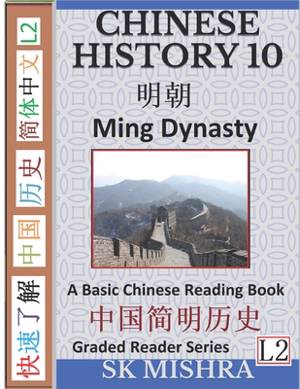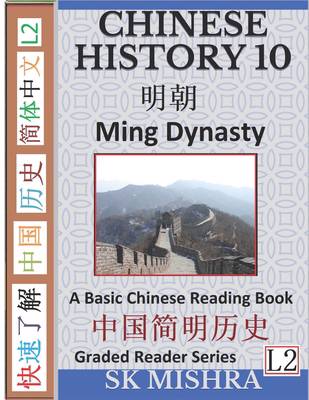
- Afhalen na 1 uur in een winkel met voorraad
- Gratis thuislevering in België vanaf € 30
- Ruim aanbod met 7 miljoen producten
- Afhalen na 1 uur in een winkel met voorraad
- Gratis thuislevering in België vanaf € 30
- Ruim aanbod met 7 miljoen producten
Zoeken
Chinese History 10
Ming Dynasty, Major Events, Rise and Fall, A Basic Chinese Reading Book (Simplified Characters, Graded Reader Series Level 2)
Sk Mishra
€ 27,95
+ 55 punten
Omschrijving
The Ming Dynasty (1368-1644), also known as the Great Ming (大明), was the last Chinese ruling dynasty established by the Han nationality. The dynasty had total 16 emperors and ruled China for a total of 276 years. After the collapse of the Yuan dynasty (元朝), the peasant rebel leader Zhu Yuanzhang (朱元璋) founded the Ming dynasty. Zhu Yuanzhang ruled China as Emperor Taizu (明太祖) and introduced several socio-economics reforms. In the late Ming dynasty, however, the peasant uprising broke out. In 1644, Li Zicheng (李自成, 1606-1645) invaded Beijing that eventually led to collapse of the Ming Dynasty. The book, Chinese History 10, a Chinese reading practice book, presents a broad and simple overview of China's Ming Dynasty, the dynasty that succeeded the Yuan Dynasty (1271-1368 CE) and was itself succeeded by the Qing dynasty (1644-1911). The new volume, part of the Mandarin Chinese Reading Series, includes both the Chinese text (simplified characters) and pinyin. With about 900 unique Chinese characters, the volume would be suitable for the beginners, lower intermediate and advanced level Chinese language learners (HSK 1-6). Overall, the Mandarin Chinese Reading Series offers you a variety of elementary level books (Level 1/2/3) to learn Chinese culture as well as practice Chinese reading fast. Paperback Edition:
https: //www.amazon.com/dp/1650251548
Kindle Edition:
https: //www.amazon.com/dp/B0832PHHBS The book has 10 chapters in the following order:
Chapter 1: Introduction to the Ming Dynasty (第一章:明代简介)
Chapter 2: Establishment of the Ming Dynasty (第二章:明朝的建立)
Chapter 3: Emperor Taizu of Ming (第三章:明太祖)
Chapter 4: Ming Dynasty Culture (第四章:明代文化)
Chapter 5: Ming Dynasty Trade (第五章:明朝贸易)
Chapter 6: Ming Dynasty Porcelain (第六章:明朝瓷器)
Chapter 7: The Great Wall of China (第七章:中国的长城)
Chapter 8: Ming Dynasty Literature (第八章:明代文学)
Chapter 9: Matteo Ricci (第九章:利玛窦)
Chapter 10: The Fall of the Ming Dynasty (第十章:明朝的秋天)
https: //www.amazon.com/dp/1650251548
Kindle Edition:
https: //www.amazon.com/dp/B0832PHHBS The book has 10 chapters in the following order:
Chapter 1: Introduction to the Ming Dynasty (第一章:明代简介)
Chapter 2: Establishment of the Ming Dynasty (第二章:明朝的建立)
Chapter 3: Emperor Taizu of Ming (第三章:明太祖)
Chapter 4: Ming Dynasty Culture (第四章:明代文化)
Chapter 5: Ming Dynasty Trade (第五章:明朝贸易)
Chapter 6: Ming Dynasty Porcelain (第六章:明朝瓷器)
Chapter 7: The Great Wall of China (第七章:中国的长城)
Chapter 8: Ming Dynasty Literature (第八章:明代文学)
Chapter 9: Matteo Ricci (第九章:利玛窦)
Chapter 10: The Fall of the Ming Dynasty (第十章:明朝的秋天)
Specificaties
Betrokkenen
- Auteur(s):
- Uitgeverij:
Inhoud
- Aantal bladzijden:
- 48
- Taal:
- Engels
- Reeks:
- Reeksnummer:
- nr. 20
Eigenschappen
- Productcode (EAN):
- 9781650251547
- Verschijningsdatum:
- 24/12/2019
- Uitvoering:
- Paperback
- Formaat:
- Trade paperback (VS)
- Afmetingen:
- 216 mm x 279 mm
- Gewicht:
- 136 g

Alleen bij Standaard Boekhandel
+ 55 punten op je klantenkaart van Standaard Boekhandel
Beoordelingen
We publiceren alleen reviews die voldoen aan de voorwaarden voor reviews. Bekijk onze voorwaarden voor reviews.











